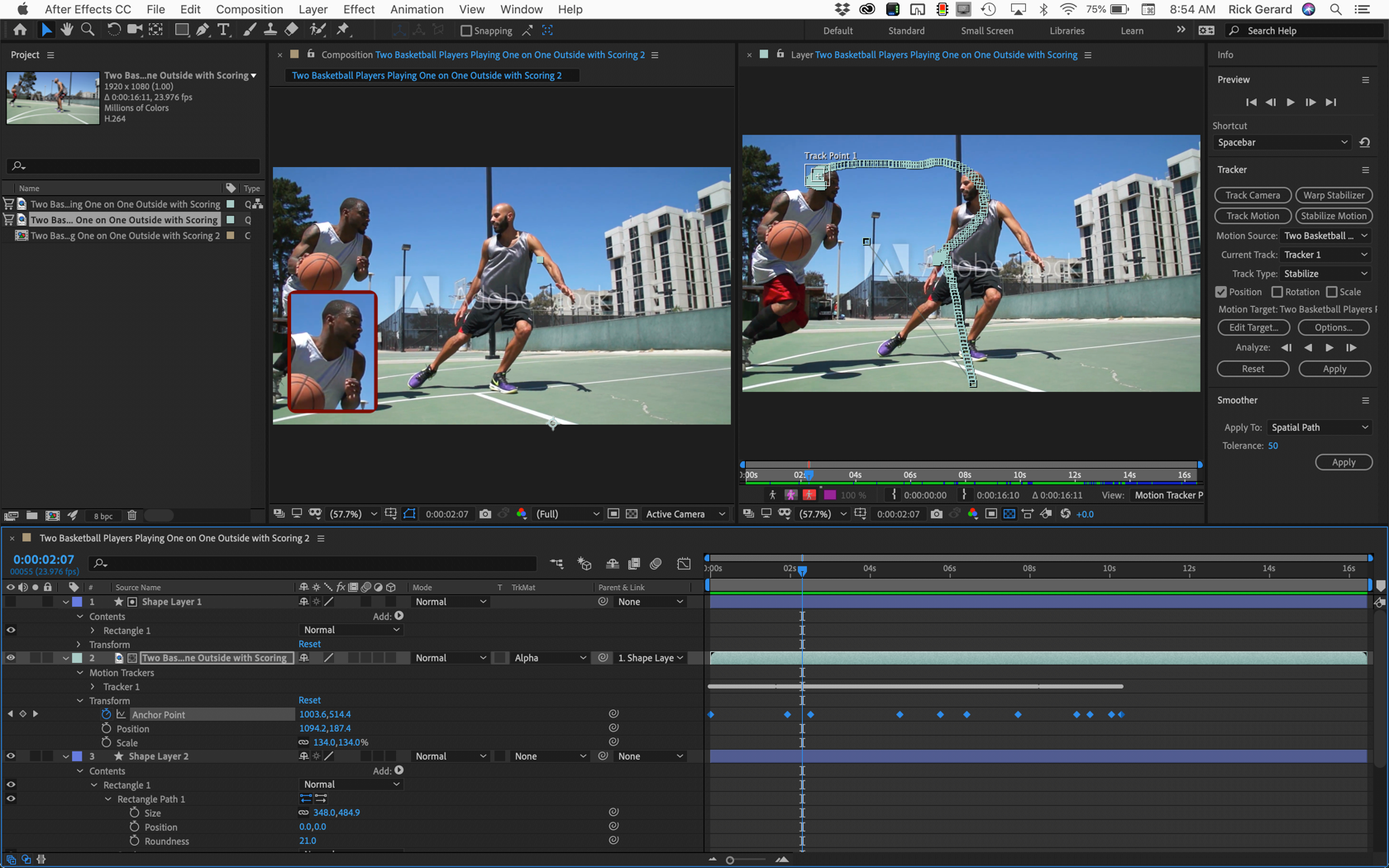Samurai Champloo Effect
Copy link to clipboard
Copied
So, this is a pretty complicated question, and I have very limited understanding of AE, but I am willing to learn. In Samurai Champloo, it seems as though the fight scenes have a "shake effect" where the camera appears to move with the characters. I know this is accomplished through something like rotoscoping. Here's an example of two characters fighting, and when they do, it seems like the camera tries to "track them".
Samurai Champloo | Mugen vs Jin | English Sub - YouTube
I am wondering how to accomplish a similar effect with regular video footage of people. Here's the effect I want:
What I will have is a scene of two people playing basketball with no movement (tripod shot, no panning or zooming). In After Effects, I want to somehow create a cropped "mini-camera" that specifically follows ONE of the two players movements, creating a "moving shot" from stable footage. What this would do is essentially "track the player", even though the original footage didn't move at all.
I know this is theoretically possible, but I cannot for the life of me figure it out or find it anywhere online. There's tons of stuff on face tracking, attaching text to a specific point, but nothing on creating a cropped shot that tracks a specific, moving target.
Any help would be SUPER appreciated.
Copy link to clipboard
Copied
I didn't see anything in the sample video that looked like anything more than animated position changes. I am assuming you are not talking about Bullet Time effects made popular in the film "The Matrix."
The apparent parallax shift is accomplished by having layers larger than the final scene arranged in 3D space so when the position of the camera is animated you get the shifts in parallax. Disney animators came up with this a long time ago:
If you want to animate camera movement in a that is shot with a locked camera and you want that parallax effect you will have to separate the foreground, middle ground and background into different layers, offset those layers in Z then animate the camera. The problem is that you will need clean plates.
To do this on a basketball court with two players you first need to shoot a clean plate so you have a background with no players. Then from the same position, you need to film your players. You would then separate the players from the background so you have just a single layer with each player. If one player passes in front of the other player you will have to make sure that the mattes are clean. Motion blur from fast action is going to make this difficult so it is best to shoot at a high shutter speed rather than a high frame rate because you can add motion blur later.
This roto process for a 10-second shot could easily take 10 to 20 hours unless you have very carefully planned and executed your filming.
If there are any foreground elements that the players will pass behind these will also have to be separated from the background.
Once you stack the layers, the way Disney did, you can then animate the camera to reproduce the same kind of effect. The layers will have to be scaled and the original footage will have to be bigger than the final project. Shoot 4K if you want HD for this kind of effect.
Your ability to simulate camera movement will be very limited because you can only accurately move perpendicular to the original camera a little bit or push in. You can motion track one of the players to help keep the focus on that player, but you will have to be very careful to avoid huge distortions in the footage.
The job of separating your actors from the background can be easier if you shoot them on a green screen, but the whole project is going to be incredibly time consuming and require a lot of planning and testing to be anything more than a clumsy experiment.
I hope this helps. This would be a huge project for me and I've been supervising and producing visual effects at one level or another for almost half a century.
Copy link to clipboard
Copied
Hey, Rick, thanks for the post.
I don't think the Parallax effect is what I'm looking for. Essentially, I want to have a fixed stable shot, and then create a smaller, cropped frame that specifically follows one player as they play basketball. What this means is that I want the frame of this smaller shot to be fixed on the person, such as their face or whatever, and to necessarily move with them.
So, yes, it would require some form of duplicated video that has been cropped to be placed over the original, and this smaller video would then need to track an aspect of the original video (the moving player). But I just don't know how to accomplish this.
Copy link to clipboard
Copied
If you are talking picture in picture try this:
- Duplicate your footage layer
- Change the workspace to Motion Tracking
- Select the top copy of your footage and select Motion Stabilize
- create a fairly large selection on one of the players on a body part that is fairly consistently pointing at the camera (see the example below)
- Apply the tracking data to the shot to stop the player from moving in the shot
- Draw a rectangle shape layer above the player large enough to crop the shot
- Parent the motion stabilized footage to the shape layer
- Move the shape layer into position in the frame
- Set the shape layer as a track matte for the motion stabilized footage
- If necessary, scale the footage and adjust the position to frame up the insert shot
- If necessary, smooth the motion stabilization using the smoothing tools in AE
Depending on the movement of the player you might be better off just setting a few keyframes to position the footage.
The comp would look something like this:

I tracked the top of the players head which you can see on the right, applied the smoother to the anchor point path with a tolerance of 50 to take out the bumps, scaled up the footage to 130% to give me a closeup and duplicated the track matte shape layer, put it below the stabilized footage and added a stroke with rounded corners to create a frame. I found the shot on Adobe Stock. The project took me less than 5 minutes. Picking a good tracking point is the hardest part. It took two tries to smooth the shot. The first was 30 pixels, the second was 50.
The reason I suggested shooting on 4K for an HD production is to avoid scaling the insert to more than 100%. I hope this helps.
Copy link to clipboard
Copied
Hi devonc,
Did Rick's workflow help?
Let us know.
Rameez
Find more inspiration, events, and resources on the new Adobe Community
Explore Now